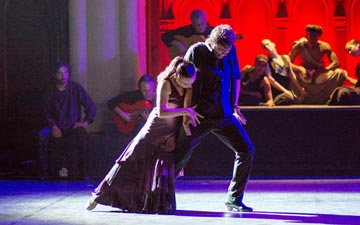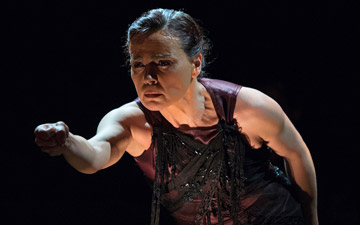
© Rachel Roberts. (Click image for larger version)
Noche Flamenca
Sombras Sagradas
New York, Joyce Theater
3 December 2013
www.nocheflamenca.net
www.joyce.org
Deep Song
Noche Flamenca, New York’s reigning flamenco troupe, has been filling the Joyce since 2011, the year it first moved up from various smaller, more rough-and-tumble venues downtown. This year, the ensemble, led by the impressive Soledad Barrio, has settled in for two weeks, a sign of the considerable appeal of its unadorned, puro style. Their no-nonsense delivery stands in stark contrast with the increasingly high-gloss production values (and over-amplification) of most touring flamenco shows. And then there is Barrio herself, a force of nature, whose searing rendition of the siguiriya – a majestic lament with eighteenth-century roots – has been, and continues to be, the climax of every Noche Flamenca outing.
Like most dances with folk roots, flamenco suffers somewhat from being cooped up in a theatre. It is, at its heart, a participatory and spontaneous art, in which the dancers, musicians, and singers feed off the energy of the group, egging each other on to a kind of transcendence of form. Of course, it’s also true that flamenco has a long tradition of being performed outside of the tablao. (As the recent flamenco exhibit at the NYPL illustrated, it became a hugely popular entertainment worldwide during and after the Spanish Civil War.) So the question becomes: how can flamenco be theatricalized without losing its explosive effect? And, conversely, how can flamenco’s loose, impulsive structure be shaped into compelling theatre? Many groups opt for elaborate showmanship, colored lights, avalanches of dry ice, battalions of highly-charged dancers, slinky costumes (or bare chests for the men), and convoluted story-lines. In most cases this treatment cheapens the form. But theatricalization can also be accomplished with taste and style and a sense of purpose; think back to some of the great flamenco films of the eighties, like the Antonio Gades/Carlos Saura collaboration Bodas de Sangre.
Barrio – who has lately become an even greater presence in the New York flamenco scene through her classes at the West Park Presbyterian Church – and her husband, Martín Santangelo, make few concessions to this gentrifying trend. They like to keep their shows very stripped down. At the Joyce, the stage is bare, amplification is subtle, lighting is artful but relatively simple. The performers’ wardrobe is plain, almost dull. Unlike most flamenco divas, Barrio makes few costume changes over the course of the evening, and her dresses have none of the extravagant ruffles and bright patterns we’ve grown accustomed to. Her first dress in this show, a maroon floor-length shift, is not particularly flattering, either, and tends to foreshorten her muscular form. She doesn’t seem to care. Because of this resistance to spectacle, the energy of their performances ebbs and flows, with thrilling passages (usually contained within semi-improvised solos) alternating with less compelling, generic choreographed group numbers that lack the focus or panache to make a strong impression.

© Andres d’Elia. (Click image for larger version)
The current show, “Sombras Sagradas” (sacred shadows), takes some time to warm up as it meanders from a rambling ensemble piece (“Amanecer”) to Barrio’s explosive siguiriya. Like most flamenco shows, it’s structured as a series of numbers. There are three dancers – Barrio and two men, Juan Ogalla and Antonio Jiménez – , as well as a strong ensemble of singers (three) and guitarists (two). A quiet, dreamily-executed guitar solo (by Eugenio Iglesias) doesn’t quite pull us into its world. (Be forewarned, the program varies slightly from one night to the next.) Iglesias’s purely instrumental ballad is followed by the evening’s sole attempt at storytelling, a danced version of the Chekhov story “The Huntsman,” performed by Soledad Barrio and Juan Ogalla.
The story is reduced to its bare bones: woman longs for man, man appears, man lingers, and then departs. As the singer, Mayte Maya, croons “que son cinco años de verte” – it’s five years since I saw you – Barrio kneels, mimes cooking on a hearth, raises her hand to her brow in sadness. Then, when her lover appears, they dance a brief, tension-filled duo – mostly side by side – after which he stalks off, without a glance. Meanwhile the accompaniment builds, from one singer to two, then the whole ensemble, including – anomalously – an electric guitar (played by the young Hamed Traore). But “El Cazador,” as the piece is called, feels pallid, constructed out of empty gestures that fail to stir up any genuine feeling. Ogalla’s dark gaze reveals little of his character’s state of mind. (He tends to dance everything while wearing a flamenco scowl, the rough equivalent of what, in tango, is sometimes referred to as cara fea.) This was also true of Ogalla’s solo later in the evening, the farruca, which came across as a showy series of hyper-masculine poses, abrupt changes of direction and dramatic flourishes, including a diagonal of almost balletic chaîné turns. His zapateo is his forte, especially quicksilver shifts of tempo, slipping into double-time, then holding back, sometimes softening to a near whisper. But, despite his showy style, Ogalla lacks real dramatic brio.
The high points of the evening were three solos. Antonio Jiménez, a younger male dancer – Barrio never shares the stage with other women – performed a blousy, rocambolesque solea por bulerías, a dance filled with sudden pauses, rhythmic shifts, and bursts of footwork. Jiménez’s performance here had that spontaneous, boozy feel of guests getting up to dance at a social gathering. His steps were free, syncopated, riddled with surprises. He leaned into the movement, playing with his center of gravity, at times almost losing his balance (intentionally, perhaps?). His connection with the larger-than-life cantaor who accompanied him, José Jiménez, was so strong that by the end they seemed to represent two sides of the same person. Jiménez (the singer) is a giant, with an enormous, wailing howl of a voice (he made a strong impression in the siguiriya as well). At the end, the two walked off together, locked in a heated conversation.
The younger, more refined vocalist Manuel Gago provided the other showstopping moment in a solo not listed on the program, a searing lament in which tender yearning (“adiós barquito velero, adiós almendro florido”) gradually devolved into a kind of debasing supplication (“dime que me quieres, aunque no sea verdad, eres el diluvio de mi perdición”). The end, in which he repeatedly moaned “dímelo, dímelo, dímelo” (say it, say it, say it), was almost too piteous to bear. Here was real, gut-wrenching emotion.
Similarly, Barrio’s siguiriya, which followed, strayed into the twilight realms of the unknown, best left un-analyzed. Barrio’s slow, majestic strides gave way to clean, fast, nervous zapateo. As she clutched at her elegant, black silk dress, shaking it wildly, this compact, tight-faced woman looked enlarged by an inner force, and beauteous. Her expression was plain but electrified, as if she’d seen a ghost. At one point, she chewed at the air, as if to get a bitter taste out of her mouth; at another, she stalked toward one of the singers, her advance so intimidating that the singer sat down in her chair. Barrio skated across the stage, off-balance, shaking her legs before her – it was hard to understand how she could stay vertical. Similarly, there was something almost poisonous about her deep, almost painful-looking backbends – unnatural on this small, tight frame – arms forming sculptural scrolls overhead. Barrio’s siguiriya needs no gussying up, no theatrical concept, to make its point. And this is what Noche Flamenca fans come for, season after season.

















[…] This week and next, Noche Flamenca, New York’s reigning flamenco troupe, is back at the Joyce. The group specializes in a stripped-down performance style that brings us as close as possible to the atmosphere of the tablao, or nightclub. No fancy concepts or heavy-handed production values. Soledad Barrio, who leads the group, is an extraordinary performer. Her specialty is the stately, smoldering siguiriya, which she performs with enormous intensity at each show. Here is my review for DanceTabs. […]
I really appreciated your review. I think you aptly described both the high and less high points of the production.
I wouldn’t be surprised if you spent some time studying flamenco.
It’s nice to find a writer with both the writing skills and insight to analyze this art from, often treated so superficially by many dance reviewers.
I think kudos should go to the fine production– it dramatic moments using lights to reveal and shadow, and intimate relationships created between singers and dancers.